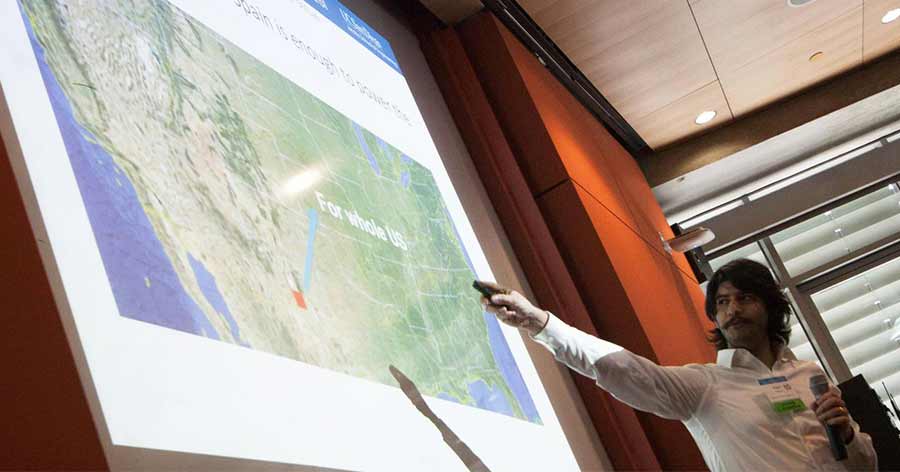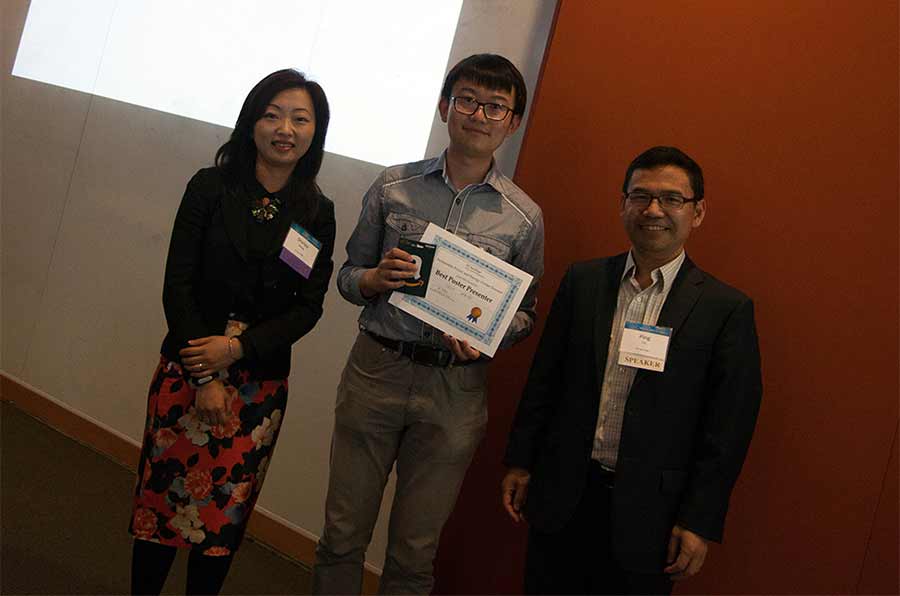
Insights from UC San Diego Sustainable Power and Energy Center Research Summit
By:
- Daniel Kane
- Deborah Osae-Oppong
Media Contact:
- Daniel Kane - dbkane@ucsd.edu
- Deborah Jude - djude@ucsd.edu
Published Date
By:
- Daniel Kane
- Deborah Osae-Oppong
Share This:
Article Content
The Sustainable Power and Energy Center (SPEC) at the University of California San Diego recently held a Research Summit for interested industry partners. Attendees from a variety of industry sectors gathered at UC San Diego to interact with faculty and graduate students, tour the UC San Diego microgrid and attend the Jacobs School’s Research Expo in the afternoon.

UC San Diego graduate student presents at SPEC Research Summit on April 14, 2016.
“Our center is quite unique in the sense that it includes engineering, physical sciences and social sciences,” said Shirley Meng, the faculty director of the Sustainable Power and Energy Center and a nanoengineering professor at the UC San Diego Jacobs School of Engineering. “We are working to engage public policy experts on campus as well, so that together we can work on sustainable power and energy from different angles.”
Center faculty are also training and mentoring tomorrow’s workforce for green and advanced energy.
“Our graduate students are often hired before they have even graduated,” said Meng. “Why is this happening? Because innovation in energy storage and conversion requires rigorous training in things like advanced materials chemistry and physics.”
Some of this rigorous training was on display at the summit when graduate students gave their 90-second research presentations during the summit’s fast break poster pitch competition.
First prize went to nanoengineering PhD student Shen Wang for his pitch on additives in solar cells. Wang is part of Shirley Meng’s Laboratory for Energy Storage and Conversion.
Wang used the analogy of a human heart to explain his research. “We can control the efficiency and stability of solar cells with additives, much like doctors use tools to improve the function of a human heart.”
Wang went on to present a related poster, Additives in Perovskite Solar Cell Play Key Role, at Research Expo, also on April 14.
The SPEC poster pitch runner up was nanoengineering graduate student Yanqi Luo, who presented a new technique for locating chlorine molecules in solar cells. Luo is part of nanoengineering professor David Fenning’s research group. He presented his poster Spatially Heterogeneous Chlorine Incorporation in Organic-Inorganic Perovskite Solar Cells at Research Expo.
“The SPEC Summit showed the impressive breadth and striking expertise of the scientists that UC San Diego has assembled to address important issues in renewables and storage. A very valuable session,” said Robert F. Hemphill, CEO, Strelitzia Ventures.
Faculty talks
New nanoengineering professor Ping Liu, who most recently served as a program director at the US Advanced Research Projects-Energy (ARPA-E), offered insights from his vantage point at the intersection of academia, federal funding agencies and industry. Liu was named a Distinguished Inventor in multiple years at HRL Laboratories and won an R&D 100 award in 2009 for a battery technology developed at the National Renewable Energy Laboratory.
“You can view a battery as a mini chemical plant, that’s why they are so complex,” said Liu. But unlike most chemical power plants, once you assemble and seal up a traditional battery, you don’t actively control the components. “There are no knobs to turn, to valves to open and close, which makes the challenge of cost-effective battery innovations even harder,” said Liu, who noted that it’s crucial to be working on technologies that will be better than the projected future improvements to today’s state of the art. It’s not enough to aim to beat the best there is today.

UC San Diego Professor and SPEC Faculty Director Shirley Meng; poster pitch winner and nanoengineering PhD student Shen Wang; and UC San Diego professor Ping Liu.
The challenges inherent in creating higher performing, less expensive batteries underscore the importance of ongoing collaborative research between the labs of SPEC faculty members Shirley Meng and Oleg Shpyrko, a UC San Diego physics professor.
These labs, and their collaborators, are focused on understanding how battery components behave at the nano-scale level while the batteries are in operation. The team published related research last year in the journal Science. (Read the paper abstract and the press release from UC San Diego.)
Nanoengineering professor Shyue Ping Ong also spoke at the SPEC research summit. Ong recently won a prestigious Young Investigator Award from the U.S. Office of Naval Research (ONR). The award is funding Ong’s work to develop new computational techniques for studying the reactions and properties of materials interfaces.
“Materials are a key bottleneck in many technologies including solar cells, magnetic materials and aircraft,” said Ong. He noted that it traditionally takes about 20 years to bring a material from discovery in the lab to commercialization. This timeframe held true for both Li ion batteries and Teflon, he said.
Ong is part of collaborative research program at UC San Diego working to reduce this time from discovery to commercialization. The effort involves combining data-driven computation for materials design with experimental research, device integration, economics and real-world testing on the UC San Diego microgrid.
Also at the research summit, computer science professor Tajana Rosing presented research on energy efficient systems and Graham Elliot, a professor in the Economics Department at UC San Diego discussed economic valuation of energy technologies.
“I enjoyed how all the speakers had diverse backgrounds and perspectives. By bringing together nano-engineering, materials science, computer science, and economics, we were able to have a holistic discussion of the challenges and opportunities we face in our energy future,” said Chris Mohajer, an Associate at CalCharge.
Following an interactive lunch, attendees toured UC San Diego’ world-renowned microgrid, which provides faculty and industry partners with opportunities to collaborate from theory all the way to device implementation and testing on a functioning microgrid.
Collaborations which extend from the computational to real-world applications are valuable, especially in competitive industries like energy storage and conversion where there is little room for error.
“The failure rate for batteries can’t be more than one per ten million,” said Meng. “If you want a successful business, you can’t afford a higher failure rate.”
Learn more about the Sustainable Power and Energy Center at UC San Diego.
Share This:
You May Also Like
Stay in the Know
Keep up with all the latest from UC San Diego. Subscribe to the newsletter today.


